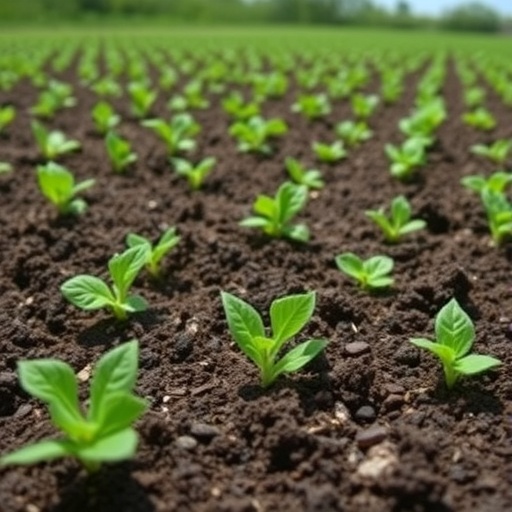Struvite, a crystalline compound composed of magnesium, ammonium, and phosphate, has been garnering significant attention in agricultural research, especially within soilless crop production systems. As the world grapples with the challenges of sustainable agriculture and the nutrient delivery in food systems, struvite emerges as a viable alternative for traditional fertilizers. Featuring in the latest study by Neofytou, Chrysargyris, and Tzortzakis, this compound’s multifaceted benefits and application potential is thoroughly analyzed, uncovering a path forward for eco-friendly farming practices.
Struvite’s composition as a slow-release fertilizer positions it as a promising player in modern agriculture. This compound is recognized not only for its nutrient content but also for its environmental benefits, including reducing nutrient runoff and mitigating water pollution caused by conventional fertilizers. By integrating struvite into soilless cropping systems, growers can manage nutrient availability more effectively, ensuring that plants receive exactly what they need while minimizing excess application.
In the context of soilless crops, where the growing medium is often inert and lacks inherent nutrients, the application of struvite can bridge the nutrient gap. Soilless systems, which include hydroponics and aeroponics, depend heavily on nutrient solutions to sustain plant growth; thus, the introduction of struvite can enhance the sustainability of these systems. As the agricultural sector increasingly shifts toward rapid production methods with reduced land usage, understanding the unique properties of struvite becomes crucial.
Moreover, the eco-friendly profile of struvite is reinforced by its sustainable production methods. Unlike synthetic fertilizers, which require substantial energy inputs and can lead to environmental degradation in their manufacturing processes, struvite can be recovered from wastewater treatment plants. This recycling of nutrients not only provides a sustainable source of fertilizer but also offers a waste management solution, addressing the dual challenges of waste disposal and nutrient scarcity.
Struvite’s potential in improving crop yields has been supported by various studies. The slow-release nature of struvite leads to prolonged nutrient availability, promoting robust plant growth over traditional fertilizers that often lead to nutrient spikes followed by declines. This controlled nutrient release aligns seamlessly with the growth patterns of crops, supporting both quality and quantity. Enhanced nutrient uptake translates into vibrant, healthy plants that are less susceptible to diseases and pest pressures, ultimately contributing to higher efficiency in food production.
The versatility of struvite extends beyond primary macronutrients, playing a significant role in soil health as well. As soil conditioners, slow-release fertilizers like struvite can improve the physical and chemical properties of substrates used in soilless systems. They contribute to favorable growth conditions, allowing crops to access essential nutrients more efficiently while maintaining the necessary pH levels in nutrient solutions.
As consumer demand shifts towards sustainably produced food, the opportunity for struvite in market gardening, particularly in urban settings, cannot be overstated. Urban agriculture stands to benefit immensely from the application of soilless systems supplemented by struvite. With a growing inclination towards locally sourced food, struvite not only minimizes transportation footprints but also enhances food security in potentially resource-constrained areas.
Furthermore, the trajectory of struvite utilization extends into the realm of integrated nutrient management. By coupling struvite with other organic amendments or fertilizers, growers can develop a tailored nutrient strategy that meets the specific demands of various crops. This holistic approach to nutrient management fosters resilience against the unpredictable nature of climate change, ensuring agricultural sustainability in the face of environmental challenges.
The implications of integrating struvite in soilless systems resonate across global initiatives aimed at achieving food security and sustainability goals. As countries strive towards ambitious agricultural targets, leveraging struvite can position farmers to both meet demand and mitigate environmental impacts. Successful case studies showcasing struvite in action provide invaluable insights into its integration, showcasing a replicable model for diverse agricultural settings.
Recognizing the potential barriers to widespread adoption, however, involves examining the economic aspects of struvite utilization. Initial costs for infrastructure modifications to incorporate struvite may deter some farmers. Nevertheless, long-term cost savings associated with progressive yield increases, reduced input expenses, and enhanced sustainability are likely to offset this challenge.
Education and outreach play a pivotal role in fostering the adoption of struvite as a nutrient source in agriculture. Engaging the farming community through workshops, demonstrations, and collaborations with research institutions will be essential in spotlighting struvite’s benefits, practical applications, and best practices. Cultivating an understanding of eco-friendly approaches to farming can usher in a new era of agricultural practices that prioritize both productivity and ecological stewardship.
Ultimately, the insights gathered from Neofytou et al.’s research form an essential foundation for advancing the acceptance and implementation of struvite-based systems. By promoting awareness and understanding of struvite, we can pave the way for agricultural innovation that harmonizes food production with environmental preservation. As the conversation surrounding sustainable agriculture continues to evolve, struvite promises to be at the forefront, offering solutions that align with nature’s principles while elevating the prospect of global food security.
In conclusion, the prospects for struvite in soilless crop production represent a significant advancement in sustainable agriculture. Its ability to provide critical nutrients, coupled with its eco-friendly attributes, positions struvite as a revolutionary tool in modern farming. As we transition towards greener practices and embrace innovative solutions, struvite stands poised to redefine nutrient management and support the agricultural sector’s growth in an increasingly resource-constrained world.
Subject of Research: The Use of Struvite in Soilless Crop Production Systems
Article Title: Prospects of the Use of Struvite in Soilless Crop Production Systems: a Review
Article References:
Neofytou, G., Chrysargyris, A. & Tzortzakis, N. Prospects of the Use of Struvite in Soilless Crop Production Systems: a Review.
Waste Biomass Valor (2025). https://doi.org/10.1007/s12649-025-03295-z
Image Credits: AI Generated
DOI:
Keywords: Struvite, soilless crop production, sustainable agriculture, nutrient management, eco-friendly fertilizers
Tags: application of struvite in aeroponicseco-friendly farming alternativesenhancing sustainability in soilless farmingenvironmental benefits of struviteinnovative fertilizers for modern agriculturemitigating water pollution from fertilizersnutrient delivery in food systemsnutrient management in hydroponicsreducing nutrient runoff in agriculturesoilless crop production systemsStruvite as a slow-release fertilizersustainable agriculture practices





